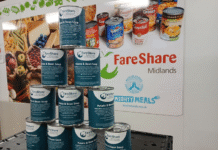
In an intensive development effort Gallus and Heidelberg engineers have further developed UV inkjet printing to enable the production of certified food-compliant labels with the Gallus Labelfire. The low migration version of the Gallus Labelfire is designed to produce food-compliant packaging in accordance with EU regulations and Swiss Ordinance. For this purpose, the joint Gallus/Heidelberg development team developed the Labelfire UVLM ink series, which is suitable for food contact packaging. The UV curing technology of Labelfire was also further optimized to improve the migration properties of the ink film.
“The Gallus Labelfire Low Migration represents a real innovation. Compared to the previous press, it makes no compromises when it comes to print quality, color gamut and lightfastness of the inks”, says Uwe Alexander, product manager digital at Gallus, describing the new digital press. Thomas Schweizer, head of business and product management at Gallus adds, “Indeed! We call it innovation because, together with Heidelberg, we have achieved a new level of UV inkjet technology. This includes the formulation of the ink and a matching curing technology. This enables our customers to comply with the relevant EU regulations as well as the guidelines of Swiss Ordinance and Nestlé Guidance Note in order to produce food-compliant labels and packaging.“
Saphira Digital Labelfire UVLM inks
A prerequisite for the food-compliant production of labels and packaging is compliance with

the relevant legislation and, in addition, the specifications of distributors and brand owners. Labelfire UVLM inks therefore comply with the requirements of EU regulations, Swiss Ordinance, Nestlé Guidance Note and EuPIA guidelines.
However, the use of such inks alone does not guarantee automatic compliance with the migration limits required for certification of such labels.
The new curing system of Labelfire Low Migration
An important production step takes place after inkjet printing with curing of the inks. In addition to the new ink series, the innovative machine system therefore also includes a highly effective UV dryer system to ensure optimum curing.
Directly after printing, the substrate is fed into a dryer with an inert chamber, which is flooded with nitrogen. The extensive exclusion of oxygen leads to optimised curing of the inks. An optional UV booster enhances curing of the Labelfire UVLM inks at higher printing speeds even at maximum production speed.
In addition to this new UV drying system, the Gallus Labelfire Low Migration is equipped with UV and oxygen sensors that measure production parameters. This supports the quality assurance processes in label and packaging printing.
“We are proud to offer our customers a machine system that prints flexibly and efficiently, but furthermore it allows a very broad range of applications and thus also addresses various market segments. The Labelfire Low Migration is perfect for a successful entry into digital packaging printing for the food and pharmaceutical markets,” Schweizer concludes.
Successful Labelfire Low Migration field tests
Two Gallus Labelfire presses have already been producing food-compliant labels and packaging in line with legal requirements for the European market for months in a field test study. Since October this year, the Gallus Labelfire Low Migration has been sold on to customers as a series machine.
IndiFoodBev — authentic, impactful and influential
An English-language food and beverage processing and packaging industry B2B platform in print and web, IndiFoodBev is in its third year of publication. It is said that the Indian food and beverage industries represent approximately US$ 900 billion in revenues which implies more than 20% of the country’s GDP. Eliminating the wastage on the farmside can help to deliver more protein to a higher number of the population apart from generating sizable exports. The savings in soil, seeds, water, fertilizer, energy and ultimately food and nutrition could be the most immense contribution that country is poised to make to the moderation of climate change.
To improve your marketing and grow sales to the food and beverage processing and packaging industry, talk to us. Our research and consulting company IppStar [www.ippstar.org] can assess your potential and addressable markets in light of the competition. We can discuss marketing, communication, and sales strategies for market entry and growth.
Suppliers and service providers with a strategy and budget for targeted marketing can discuss using our hybrid print, web, video, and social media channels to create brand recognition linked to market relevance. Our technical writers are ready to meet you and your customers for content.
The second largest producer of fruit and vegetables in the world is continuously expanding processing capacities and delivery systems with appropriate innovative technologies. We cover product and consumer trends, nutrition, processing, research, equipment and packaging from farm to thali. Get our 2025 media kit and recalibrate your role in this dynamic market. Enhance your visibility and relevance to existing markets and turn potential customers into conversations. Ask for a sample copy of our bi-monthly in print or our weekly IndiFoodBev eZine each Wednesday.
For editorial info@ippgroup.in — for advertisement ads1@ippgroup.in and for subscriptions subscription@ippgroup.in
Naresh Khanna – 10 February 2025
Subscribe Now










